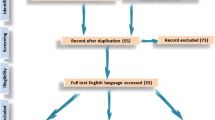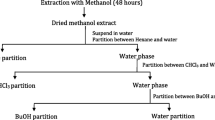Abstract
The present study was conducted to prepare a compound plant extract as a candidate animal feed additive. Firstly, Evodia rutaecarpa (ER), Schisandra sphenanthera (SS), Punica granatum (PG) and Artemisia argyi (AA) were screened out from 17 plants as materials of candidate compound plant extracts by measuring the antibacterial rate on Escherichia coli and Salmonella paratyphoid, and the scavenging capability on 2,2 diphenyl-1-picrylhydrazine radical in vitro. Secondly, proportions of the four materials were optimized with an L9 (43) orthogonal experiment. By range analysis of experimental results, two compound extracts (named as F1 and F2) with the strongest antibacterial and antioxidant functions were obtained. The ratio of ER: SS: PG: AA is 9:9:1:3 in F1 and 9:9:9:3 in F2, respectively. Finally, the effects of F1 and F2 on security and efficacy in vivo were evaluated. In healthy mice, F1 had no significant effects (p > 0.05) on all blood parameters and viscera indices, and at 1000 mg/kg bw dose significantly increased (p < 0.05) the average daily gain (ADG). F2 decreased (p < 0.05) white blood cell count at 3000 mg/kg bw and increased (p < 0.05) red blood cell count at 333 mg/kg bw. In immunosuppressed mice, both F1 and F2 improved ADG (p < 0.05) and the feed intake to gain ratio (p < 0.01), and increased the activities of hepatic superoxide dismutase (p < 0.05), catalase (p < 0.05) and total antioxygen capacity (p < 0.05), and the content of malonaldehyde (p < 0.01). In mice challenged with Escherichia coli, the antidiarrhea and reducing mortality effects of F1 were equivalent to the antibiotic. F2 failed to protect the experimental mice. These results suggested F1, a compound plant extract, show a great potential as a substitute for antibiotics in animal feed.


Similar content being viewed by others

Data availability
All the data used in the current study are available from the corresponding author on reasonable request.
References
Aluko RE, Monu E (2003) Functional and bioactive properties of quinoa seed protein hydrolysates. J Food Sci 68:1254–1258. https://doi.org/10.1111/j.1365-2621.2003.tb09635.x
Chen Y, Tang J, Wang X, Sun FX, Liang SJ (2012) An immunostimulatory polysaccharide (SCP-IIa) from the fruit of Schisandra chinensis (Turcz.) Baill. Int J Biol Macromol 50:844–848. https://doi.org/10.1016/j.ijbiomac.2011.11.015
CLSI (2010) performance standards for antimicrobial susceptibility testing: 20th informational supplement. CLSI document M100-S20. Clinical and Laboratory Standards Institute, Wayne, PA.
Guan X, Ge D, Li S, Huang K, Liu J, Li F (2019) Chemical composition and antimicrobial activities of Artemisia argyi lévl. et vant essential oils extracted by simultaneous distillation-extraction, subcritical extraction and hydrodistillation. Molecules 24:483. https://doi.org/10.3390/molecules24030483
Han B, Xin Z, Ma S, Liu W, Zhang B, Ran L, Yi L, Ren D (2017) Comprehensive characterization and identification of antioxidants in folium Artemisiae argyi using high-resolution tandem mass spectrometry. J Chromatogr B Analyt Technol Biomed Life Sci 1063:84–92. https://doi.org/10.1016/j.jchromb.2017.08.021
Hu M, Zhang H, Feng B, Liu K, Guo S (2013) Extraction of polysaccharides from Fomes officinalis Ames and their antitumor activity. Exp Ther Med 6(2):451–454. https://doi.org/10.3892/etm.2013.1163
Jose T, Pattanaik AK, Jadhav SE, Dutta N, Sharma S (2017) Nutrient digestibility, hindgut metabolites and antioxidant status of dogs supplemented with pomegranate peel extract. J Nutr Sci 6:e36. https://doi.org/10.1017/jns.2017.34
Ko HC, Wang YH, Liou KT, Chen CM, Chen CH, Wang WY, Chang S, Hou YC, Chen KT, Chen CF, Shen YC (2007) Anti-inflammatory effects and mechanisms of the ethanol extract of Evodia rutaecarpa and its bioactive components on neutrophils and microglial cells. Eur J Pharmacol 555:211–217. https://doi.org/10.1016/j.ejphar.2006.10.002
Lan MB, Zhang YH, Zheng Y, Yuan HH, Zhao HL, Gao F (2010) Antioxidant and immunomodulatory activities of polysaccharides from moxa (Artemisia argyi) leaf. Food Sci Biotechnol 19:1463–1469. https://doi.org/10.1007/s10068-010-0209-5
Li Z, He X, Liu F, Wang J, Feng J (2018) A review of polysaccharides from Schisandra chinensis and Schisandra sphenanthera: properties, functions and applications. Carbohydr Polym 184:178–190. https://doi.org/10.1016/j.carbpol.2017.12.058
Liang X, Li B, Wu F, Li T, Wang Y, Ma Q, Liang S (2017) Bitterness and antibacterial activities of constituents from Evodia rutaecarpa. BMC Complement Altern Med 17:180. https://doi.org/10.1186/s12906-017-1701-8
Liang WH, Chang TW, Charng YC (2018) Effects of drying methods on contents of bioactive compounds and antioxidant activities of Angelica dahurica. Food Sci Biotechnol 27:1085–1092. https://doi.org/10.1007/s10068-018-0359-4
Liu HW, Tong JM, Zhou DW (2011) Utilization of Chinese herbal feed additives in animal production. Agric Sci China 10:1262–1272. https://doi.org/10.1016/S1671-2927(11)60118-1
Liu L, Zuo W, Li F (2019) Dietary addition of Artemisia argyi reduces diarrhea and modulates the gut immune function without affecting growth performances of rabbits after weaning. J Anim Sci 97:1693–1700. https://doi.org/10.1093/jas/skz047
Malviya S, Jha A, Hettiarachchy N (2014) Antioxidant and antibacterial potential of pomegranate peel extracts. J Food Sci Technol 51:4132–4137. https://doi.org/10.1007/s13197-013-0956-4
Niwano Y, Saito K, Yoshizaki F, Kohno M, Ozawa T (2011) Extensive screening for herbal extracts with potent antioxidant properties. J Clin Biochem Nutr 48:84. https://doi.org/10.3164/jcbn.11-013FR
Rajabi M, Rouzbehan Y, Rezaei J (2017) A strategy to improve nitrogen utilization, reduce environmental impact, and increase performance and antioxidant capacity of fattening lambs using pomegranate peel extract. J Anim Sci 95:499. https://doi.org/10.2527/jas2016.1069
Verma AR, Vijayakumar M, Mathela CS, Rao CV (2009) In vitro and in vivo antioxidant properties of different fractions of Moringa oleifera leaves. Food Chem Toxicol 47:2196–2201. https://doi.org/10.1016/j.fct.2009.06.005
Viuda-Martos M, Fernández-López J, Pérez-Álvarez JA (2010) Pomegranate and its many functional components as related to human health: a review. Compr Rev Food Sci F 9:635–654. https://doi.org/10.1111/j.1541-4337.2010.00131.x
Wang XX, Zan K, Shi SP, Zeng KW, Jiang Y, Guan Y, Xiao CL, Gao HY, Wu LJ, Tu PF (2013) Quinolone alkaloids with antibacterial and cytotoxic activities from the fruits of Evodia rutaecarpa. Fitoterapia 89:1–7. https://doi.org/10.1016/j.fifitote.2013.04.007
Windisch W, Schedle K, Plitzner C, Kroismayr A (2008) Use of phytogenic products as feed additives for swine and poultry. J Anim Sci 86:E140-148. https://doi.org/10.2527/jas.2007-0459
Xia JX, Zhao BB, Zan JF, Wang P, Chen LL (2019) Simultaneous determination of phenolic acids and flavonoids in Artemisiae argyi Folium by HPLC-MS/MS and discovery of antioxidant ingredients based on relevance analysis. J Pharm Biomed 175:1–8. https://doi.org/10.1016/j.jpba.2019.06.031
Xiang K, Cheng L, Luo Z, Ren J, Tian F, Tang L, Dai R (2014) Glycyrrhizin suppresses the expressions of HMGB1 and relieves the severity of traumatic pancreatitis in rats. PLoS ONE 9:e115982. https://doi.org/10.1371/journal.pone.0115982
Xu SF, Ye YP, Chen FY (2011) Chemical composition and antioxidant activities of different polysaccharides from the roots of Angelica dahurica. Chem Biodivers 8:1121–1131. https://doi.org/10.1002/cbdv.201000233
Yu L, Liao J, Chen C (2000) Anti-diarrheal effect of water extract of Evodiae fructus in mice. J Ethnopharmacol 73:39–45. https://doi.org/10.1016/S0378-8741(00)00267-1
Zhang PF, Shi BL, Su JL, Yue YX, Cao ZX, Chu WB, Li K, Yan SM (2017) Relieving effect of Artemisia argyi aqueous extract on immune stress in broilers. J Anim Physiol Anim Nutr 101:251–258. https://doi.org/10.1111/jpn.12553
Zhao T, Feng Y, Li J, Mao RW, Zou Y, Feng WW, Zheng D, Wang W, Chen Y, Yang L, Wu X (2014) Schisandra polysaccharide evokes immunomodulatory activity through TLR 4-mediated activation of macrophages. Int J Biol Macromol 65:33–40. https://doi.org/10.1016/j.ijbiomac.2014.01.018
Zhao LM, Jia YL, Ma M, Duan YQ, Liu LH (2015) Prevention effects of Schisandra polysaccharide on radiation-induced immune system dysfunction. Int J Biol Macromol 76:63–69. https://doi.org/10.1016/j.ijbiomac.2015.02.020
Zhao F, Shi B, Sun D, Chen H, Tong M, Zhang P, Guo X, Yan S (2016) Effects of dietary supplementation of Artemisia argyi aqueous extract on antioxidant indexes of small intestine in broilers. Anim Nutr 2:76–81. https://doi.org/10.1016/j.aninu.2016.06.006
Funding
This work was supported by grants from the Zhejiang Provincial Public Welfare Technology Applied Research Project (LGN18C170004), the Science Technology Department of Zhejiang Province (2018C02035, 2018C02044 and 2016C02054), the Major Research Project from Zhejiang Province (2021-2024), and the earmarked fund for China Agriculture Research System (CARS-35). The funders had no role in study collection, data collection and analysis, decision to publish, or preparation of the manuscript.
Author information
Authors and Affiliations
Contributions
XT and ZWX conceived of the study. YQS performed the investigation, analyzed the results and wrote the manuscript. XMM helped to revise the manuscript.
Corresponding author
Ethics declarations
Conflict of interest
The authors declare that they have no competing interests.
Rights and permissions
About this article
Cite this article
Tao, X., Sun, Y., Men, X. et al. A compound plant extract and its antibacterial and antioxidant properties in vitro and in vivo. 3 Biotech 10, 532 (2020). https://doi.org/10.1007/s13205-020-02529-2
Received:
Accepted:
Published:
DOI: https://doi.org/10.1007/s13205-020-02529-2



